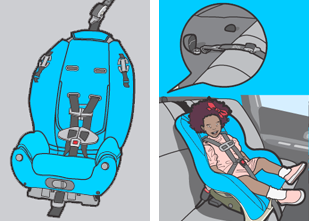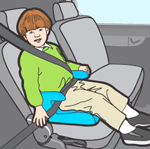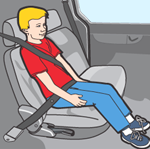Child car seats
Keeping your children safe
Last updated: August 2023
More topics
Child passenger safety best practices
Each year in B.C., an average of 1,300 children aged nine and under are injured and five are killed in motor vehicle crashes. Every time a child travels as a passenger in a motor vehicle, they are at risk of being involved in a collision. Research shows that a correctly used child safety seat reduces the risk of fatality by 71 per cent and the risk of serious injury by 67 per cent. A child who is not properly restrained can be ejected from the vehicle or thrown around the vehicle, resulting in significant injuries or death.
The correct use of a Canadian Motor Vehicle Safety Standards — approved child safety seat will ensure a child is properly restrained and significantly reduce their risk of serious injury or death in the event of a crash. It's your responsibility as the driver to make sure that all your passengers are properly secured with seatbelts or child-restraint systems.
Stage 1 — Rear-facing
From birth until at least one year old and 9 kg (20 lbs).
Place in back seat. Position centre-rear.
Do not install on front seat in proximity to an active airbag.
Don't rush to switch to a forward-facing seat — these guidelines are just the minimum requirements. Rear-facing child seats are safest for your baby or toddler, as they provide better support for their head and neck, as long as your child's weight is within the seat manufacturer's stated limit.
Use a convertible seat in the rear-facing position if the baby has outgrown the weight limit of the infant seat.

Rear-facing infant/child seat
Stage 2 — Forward-facing with tether
Must be over one year old and over 9 kg (20 lbs).
Up to at least 18 kg (40 lbs).
Place in back seat.
May remain rear-facing if allowed by manufacturer's weight limits.
Always use with a tether strap.
Taller children may fit a combination harness/booster seat better.

Forward-facing child/booster seat (convertible)
Stage 3 — Booster seat
Booster seats ensure proper seatbelt fit. They raise the child to correctly position the adult seatbelt across the bony structures of the chest and pelvis. It's safest if a child remains in a booster seat until they reach 145 cm (4'9").
Must be over 18 kg (40 lbs).
Required until at least nine years old or 145 cm (4'9"), whichever comes first.
Place in back seat.
Booster is used with a lap/shoulder seatbelt.
Position lap belt low over hip bones and shoulder belt over shoulder and in front of chest.
Do not use a booster seat with only a lap belt.

Stage 4 — Seatbelt only
It's recommended you keep children in the back seat until 12 years of age.
The lap belt should fit low over the pelvic bones.
Shoulder belt should fit over the shoulder and snug across the chest.
Never put the shoulder belt under the arm or behind the back. This could cause serious injury in the event of a crash.
Keep the seat in an upright position, not reclined. Seatbelts were designed for upright seating. A deeply reclined seat can cause a passenger to slide out from under the seatbelt in the event of a crash.

It's okay to exceed the legal requirements if in accordance with the manufacturers' maximum height/weight specifications for a seat.
More information
Call 1-800-333-0371 (toll free) or visit Transport Canada website.